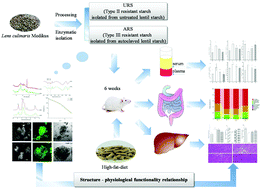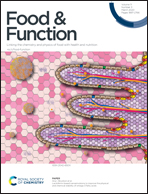A more pronounced effect of type III resistant starch vs. type II resistant starch on ameliorating hyperlipidemia in high fat diet-fed mice is associated with its supramolecular structural characteristics†
Abstract
The anti-obesity effects of two categories of resistant starch (RS) including RS2 (isolated from untreated lentil starch, URS) and RS3 (isolated from autoclaved and retrograded lentil starch, ARS) on mice with high-fat (HF) diet-induced obesity and the supramolecular structure-in vivo physiological functionality relationship of RS were investigated. Following 6 consecutive weeks, the obese mice in the two RS administered groups displayed suppression of body/liver weight gain and an improvement in serum glucose/lipid profile, antioxidant status, and gut microbiota structure. Compared with the URS intervention group, the ARS administration resulted in a more pronounced effect in controlling body weight, together with a more prominent reduction in blood glucose and triglyceride concentration, as well as a significant increase in the HDL-c level in obese mice. The ARS group also showed an absolute advantage over URS in suppressing the oxidative stress and regulating the liver function induced by the HF diet. Simultaneously, the administration of URS and ARS efficiently suppressed the HF-diet induced alterations in gut microbial ecology, with an obviously decreased ratio of Firmicutes to Bacteroidetes, especially for the ARS group, suggesting its beneficial role in gastrointestinal tract health. The structural characterization results revealed that ARS and URS differed significantly in their supramolecular structural characteristics, where ARS exhibited a higher proportion of crystallinity and double helix content with an X-ray diffraction pattern of a CB type crystal polymorph and a low proportion of molecular inhomogeneity. This study suggested that the difference in the anti-obesity effect of resistant starches was a consequence of the diversity in their structural features.



 Please wait while we load your content...
Please wait while we load your content...